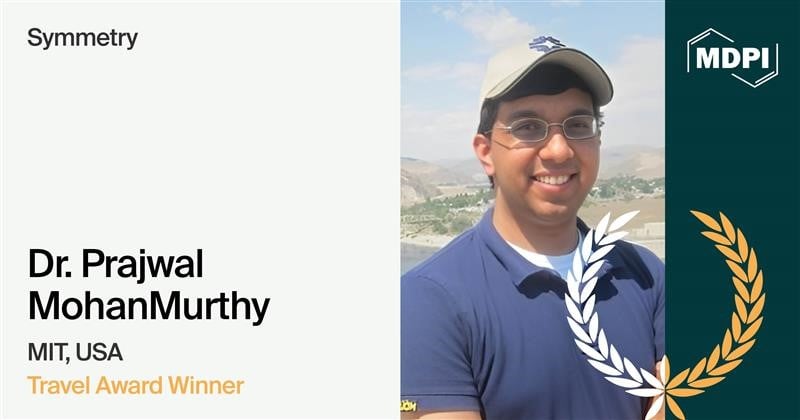
Journal Menu
► ▼ Journal Menu-
- Symmetry Home
- Aims & Scope
- Editorial Board
- Reviewer Board
- Topical Advisory Panel
- Instructions for Authors
- Special Issues
- Topics
- Sections & Collections
- Article Processing Charge
- Indexing & Archiving
- Editor’s Choice Articles
- Most Cited & Viewed
- Journal Statistics
- Journal History
- Journal Awards
- Conferences
- Editorial Office
Journal Browser
► ▼ Journal BrowserNeed Help?
Announcements
7 May 2025
Interview with Dr. Prajwal MohanMurthy—Winner of the Symmetry 2025 Travel Award

We are pleased to announce that Dr. Prajwal MohanMurthy, a senior postdoctoral research associate at Massachusetts Institute of Technology, USA, has won the Symmetry 2025 Travel Award. As the winner, he will receive an honorarium of CHF 800 and an electronic certificate.
The following is an interview with Dr. Prajwal MohanMurthy:
1. Could you please briefly introduce yourself to our readers?
I am a senior postdoctoral research associate at MIT, focusing on fundamental symmetries conducted at the intersections of nuclear and atomic physics, where I employ techniques from condensed-matter and low-temperature physics, with results often competing with and being relevant for particle physics. My current laboratory activity is building atomic beam sources of Helium and Radium, but my current undertakings span the gamut of work in nuclear structure, using astrophysical messengers for studying fundamental nuclear physics, as well as atomic and nuclear spectroscopy, and applying quantum techniques to atomic magnetometry. Much of the work is ultimately aimed at measuring electric dipole moments of atoms and molecules with highly deformed nuclei, as well as those of the neutron. I obtained my M.S. and Ph.D. degrees at MIT and ETH Zurich, respectively, working on the most recent measurements of the neutron EDM. My previous work involved an axion search, work on directly measuring neutrinos’ mass, and Compton polarimetry. I remain interested in allied physics searches for axions, axion-like-particles, oscillations in neutrons involving dark matter candidates, and mini-charges. I was born in India and grew up in India and the US, where I have now lived for most of my life.
2. Congratulations on winning the Symmetry 2025 Travel Awards! How do you feel about winning the award? How did winning this award impact your career, and what do you hope to do?
It is a great honor, and of course, travel grants help overcome financial barriers, especially when we have exciting new results to announce in often allied but unfunded directions.
3. What is your current research about and why did you choose this research field?
Some details of my current work are provided in the answer to #1. To add to this: I particularly like to think about fundamental questions like why are we here and how did we get here? To me, that has meant essentially completing the measurement of parameters of the standard model. I particularly like to work independently or in small groups, where I know most collaborators personally or where I am able to play a large and definitive role in the entire experiment from start to finish. As an experimentalist, a combination of those interests has ultimately led me to my current field at the intersections of nuclear and atomic physics. I of course did not start off in this sub-field more than 15 years ago. I started with nuclear physics at medium energies, exploring fixed-target experiments, but ultimately arrived at this juncture very much intentionally, mostly by personal initiative, as well as a lot of luck. I am strongly convinced that there are discoveries at the frontiers of physics waiting to be made in this small niche, and that these discoveries are not a matter of if but when!
4. Symmetry is an open access (OA) journal. What do you think the impact of OA on authors is?
I am a huge supporter of pre-print archives, which provide nearly finalized results to the public without being blocked by a paywall. But I often find myself referring to a finalized peer reviewed version of an article in the journal. This highlights the importance and trust I place in peer review. OA is one of the ways in which the rigor of peer review can be combined with open (public) access. I think as a publicly funded researcher, I feel an obligation to make my work accessible to the public.
5. Where did you learn about how to apply for this journal award? What do you think about journal awards?
I had initially published two articles in this journal, prompted by invitations from colleagues who are well known in the community. That directly made me aware of this journal award. There are various forms of journal awards, including ones like this, but also effectively in the form of various versions of Editor's Choice Articles. All these awards really help attract the attention of readers, who have so many choices and resources to narrow their focus onto a small topic and class of articles.
6. Do you have any thoughts on how the promotion of the journal at conferences could be more effective?
When it is hard for me to follow journal articles, I often find myself searching for talks that the same authors have given to help me understand the published material better. I usually end up finding such talks at a conference or a workshop, which has published video presentations or slides. Trying to critically understand the work in a journal article is often a lot of work. Tying such slides, talks or presentations and published articles together and formally cross-referencing them would go a long way!
Once more, congratulations to Dr. Prajwal MohanMurthy. We would also like to thank all the applicants for submitting their diverse and fascinating research topics.
For more information about the journal awards, please click on the following link: https://www.mdpi.com/journal/symmetry/awards.



